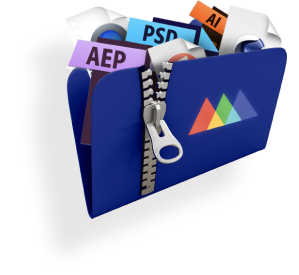
I'm going to show you how you can find clients on LinkedIn using the front door, the back door, and the side door (which requires a secret knock and the secret handshake.) Let's dive into the three ways to use LinkedIn.
To become a successful freelancer, or even to find a dream job, you have to be willing to do the legwork. While you may have read guides like the Freelance Manifesto, sometimes you still need to see things in action. Heck, that's the whole foundation behind School of Motion's courses, tutorials, and workshops. So let's dive into a LinkedIn tutorial and show you how you can find hundreds of potential clients to start chasing down.
The Front Door
We're going to start with what I call the front door. Now whether you're looking for a full-time work or you're a freelancer, I find that most motion designers use LinkedIn in an inefficient way. They're using it like any other social media platform where you post content and you hope that people engage with that content and maybe potential clients see it and then they think oh this art is great I'm gonna hire them for my next project.
I call that an inbound sales approach and it's the same thing that a fisherman does putting a worm on a hook and casting it out into the sea and hoping to get a bite. While that can work, it really works best if your work is already awesome right? If you're starting out if you're looking for that first full-time job that's not a very efficient strategy so I'm going to teach you the outbound strategy where you are actually going to go out and you are going to find clients to work for.
The first tactic which is going through the front door and just using the job search functionality inside of LinkedIn. So here's how this works.
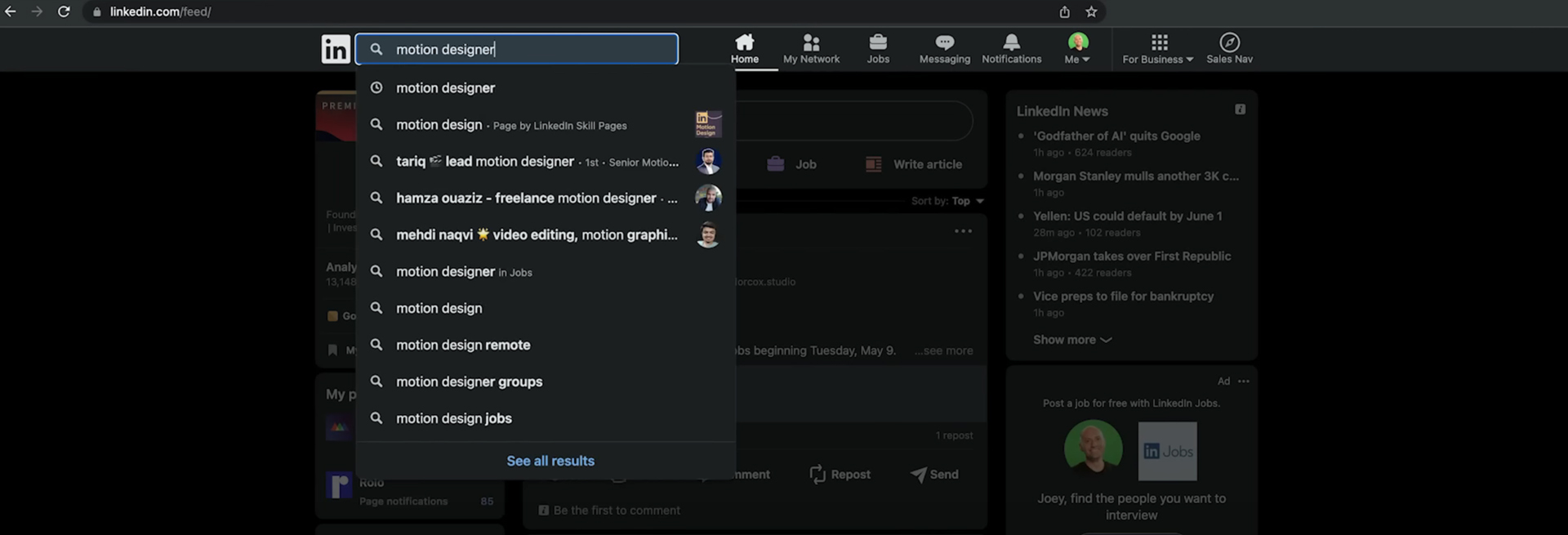
You're going to go up to the LinkedIn search bar and you're going to type in a search term let's say "motion designer." Now by default LinkedIn is going to show you people who are motion designers. This is not actually what you want at this point. You're looking for jobs so we're going to come up and click on jobs now. Because I'm in the United States, LinkedIn is automatically applied this geography filter to it but you can see that there are more results for jobs that contain the term motion designer or some combination of those words in the US.
Now if you've ever looked for a job chances are you've already done this part before. This is actually not that useful by default. You need to narrow down the results a little bit to get anything useful out of this tactic. Go to all filters we can narrow this down a little bit so right now it's showing me jobs that are posted basically at any time and the problem with this is that some of these jobs may have been posted six months ago and no one bothered to take them down. Let's look for jobs posted in the past week and then show those results. Now we have 722 results in the United States for motion designer jobs. Now it's obvious why this is useful, especially if you're looking for a full-time job. But what if you're a freelancer? Well the way I like to look at it is if a company is looking for a full-time motion designer, chances are they also need freelance help from time to time. This tells you that this company is very likely going to hire freelancers and so you should reach out to them.
What I always like to point out here is just the variety of companies that hire motion designers so there are things that are really obvious like Ogilvy is a big Ad Agency it's very obvious why they would hire a motion designer. The New Orlean Pelicans they are an NBA team and so it's also obvious why they would hire a motion designer. But who the heck is Acunor and why is Acunor hiring a motion designer? I actually don't know and I'm kind of curious so let's find out. I've looked through their website and I honestly I couldn't tell you what they do, something to do with technology. But hey, that's the world we're living in. Every company now has to make content in some form and that's going to be video content, it's going to be animated content, it's going to be still design content, and motion designers happen to be the Swiss army knife that can kind of move between all three of those worlds relatively seamlessly. So even a company like Acunor is hiring a full-time motion designer and because you now know that this company exists and that they hire motion designers, if you're a freelancer that's also now a target for you to reach out to.
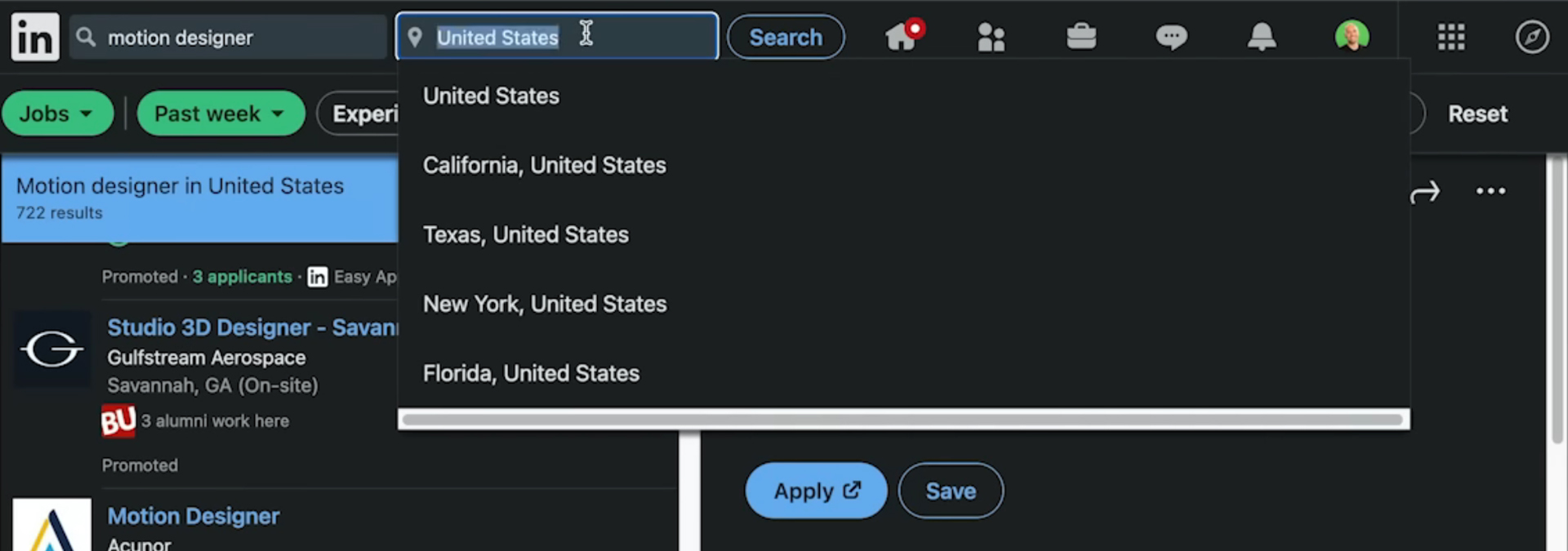
These are just basic filters, and in a minute I'm going to show you how you can access some really Advanced filters in LinkedIn but even this level of filtering is really really useful. Let's say that you live in London. You can filter for jobs that were posted in the past week just in London and you can see there's 59 results here. Now currently we're using the search term motion designer, but you can play around with other search terms too and I find that using different search terms is really helpful because most people are lazy. If they are a motion designer looking for a motion design job, they're going to go on LinkedIn and search for motion design. But what if you search for After Effects? What if you search for video? What If you search for animation? You just do a little more digging and you're working harder than most people.
You'll have better results so if I change the keyword to After Effects but we're still looking in London jobs that were posted in the last week, now there's 349 results. What about in Florida, in my neck of the woods? 550 results just in Florida and you see by changing that search term I get a lot of different types of jobs that pop up. Multimedia designer now I don't think most people come to school in motion saying I want to be a multimedia designer but you have to learn to accept the language that your clients are using and just roll with it. Legacy companies and HR departments are not as is hip to the motion design world as we are, and so they may still use terms like multimedia designer when really what they mean is someone who can do a little bit of video editing and who can make animated content for social media and other channels.
What if we change the search term to Cinema 4D and just look everywhere in the United States? There's a hundred and three results and you see some really interesting opportunities like Target, you know this huge box store and they are hiring an associate producer for Motion Graphics. Depending on what stage of your career you're in, that might be a really appealing role. Those big corporate jobs tend to be a little bit cushier in terms of work/life balance, they tend to have great benefits and good salaries and so if I was looking for a full-time job I probably would apply to this. You may have noticed there's a bunch of other filters up here but generally I think it's fine to just stay with one level of filters when you're getting a hundred results or a few hundred results. If you're finding that you're getting tens of thousands of results, then play around with those filters. That's the front door. The obvious way to use LinkedIn to find potential jobs or potential clients.
The Back Door
Let's talk about a sneakier way, what I call the back door. Back on the home page and now I'm going to type in freelance motion designer, and for this search I actually am looking for people so there are 53,000 results on LinkedIn for people that have freelance motion designer in their LinkedIn profile somewhere. That's a lot and that doesn't even factor in that tons of freelancers, maybe most, don't actually call themselves freelance motion designer. They may just say motion designer or animator or designer animator or something like that. Now why are we looking at people instead of jobs? Well, let's try this. Go to locations and I'm going to once again put in Florida. There's a bunch of Floridian motion designers, and I know because I've done this search before, that I'm very likely going to find a bunch of Ringling graduates which is pretty standard when you look for motion designers in Florida.
I'm looking for names that I don't recognize, and here's an artist who's in Orlando, Emilio. Let's check out Emilio's profile. Their portfolio is right here made it very easy to find, thank you Emilio, very nice template I like this. I see a lot of work on here for companies I don't recognize, like what is Speechly? What is Abaco Systems? I don't know, but I do know that they hire motion designers! Here is a video for Cisco Systems, and Cisco is a massive company so it's not surprising that they would hire motion designers. I'm seeing you.com I'm seeing wig wag, I don't know what any of these companies are, but I know that Emilio has done work for them and if Emilio's done work for them, maybe I could do work for them.
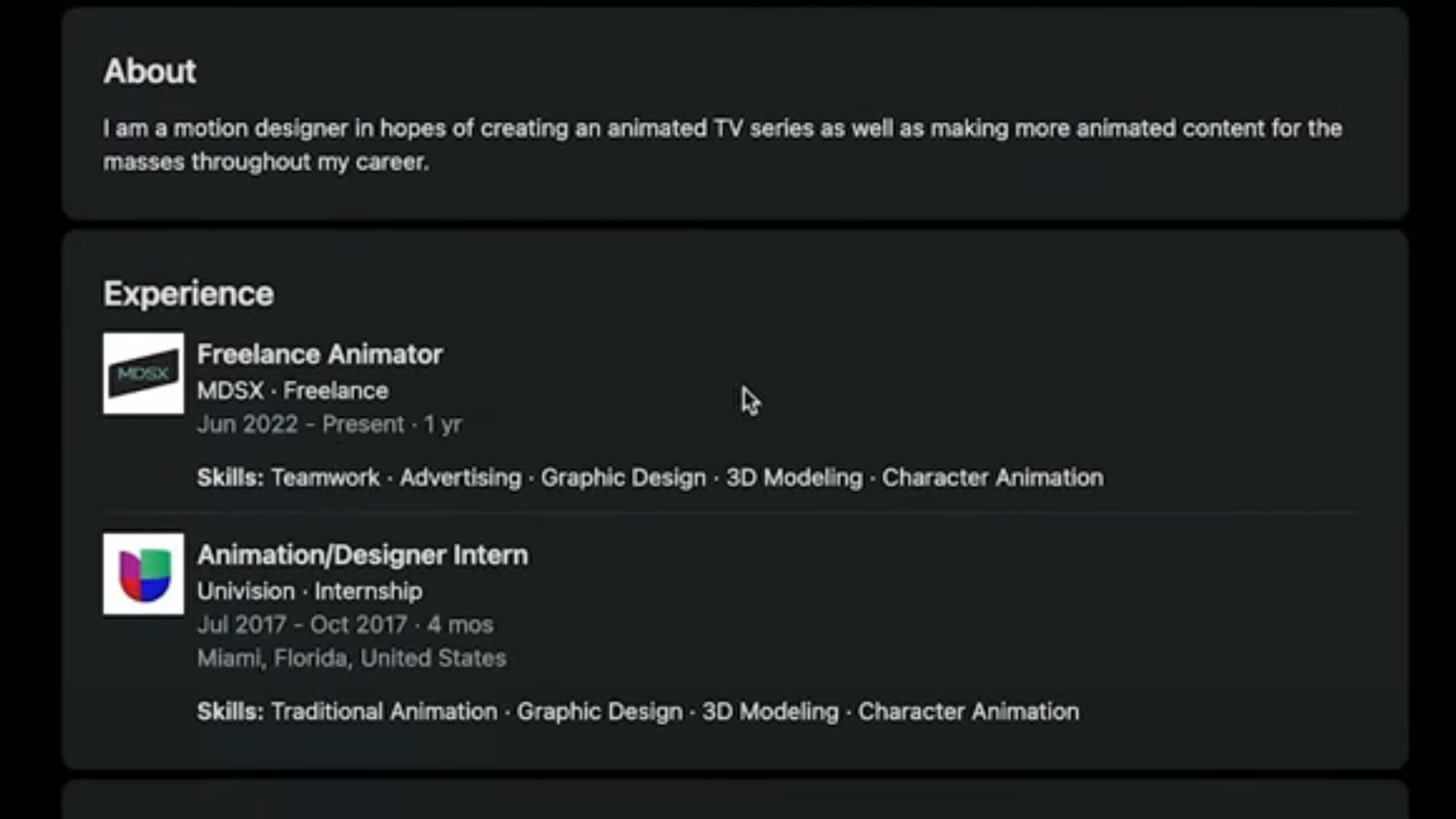
Here's another artist I'm unfamiliar with, Kristen Molina in Miami. So let's check out her profile, and right here at the top I can see that she's a freelance animator for MDSX and I don't know what that is so let's Google that. MDSX Creative, oh this looks cool this looks like some sort of agency that I didn't know existed that is in Florida. This is excellent I live an hour and a half from Orlando, Florida it'd be very easy for me to like take a day trip and go visit them if I was thinking of trying to approach them for work, and that's cool. I love meeting artists in Florida so this is great.
I didn't know they existed and the point I'm trying to make with this backdoor approach is I didn't find them by looking for motion design jobs I found them by looking for motion designers and seeing who they work with. So it's kind of this roundabout way of finding companies that hire motion designers. Not to look for companies, but to look for motion designers and then do a little bit of Google stalking, a little bit of LinkedIn stalking, and you're gonna build up a much bigger and broader lead list doing it this way.
LinkedIn Sales Navigator
Now I'm going to show you the third way, and this is a really powerful way to use LinkedIn. Unfortunately you do have to pay for something, so if you use LinkedIn you may have noticed this little button up here sales now this is referring to Sales Navigator.
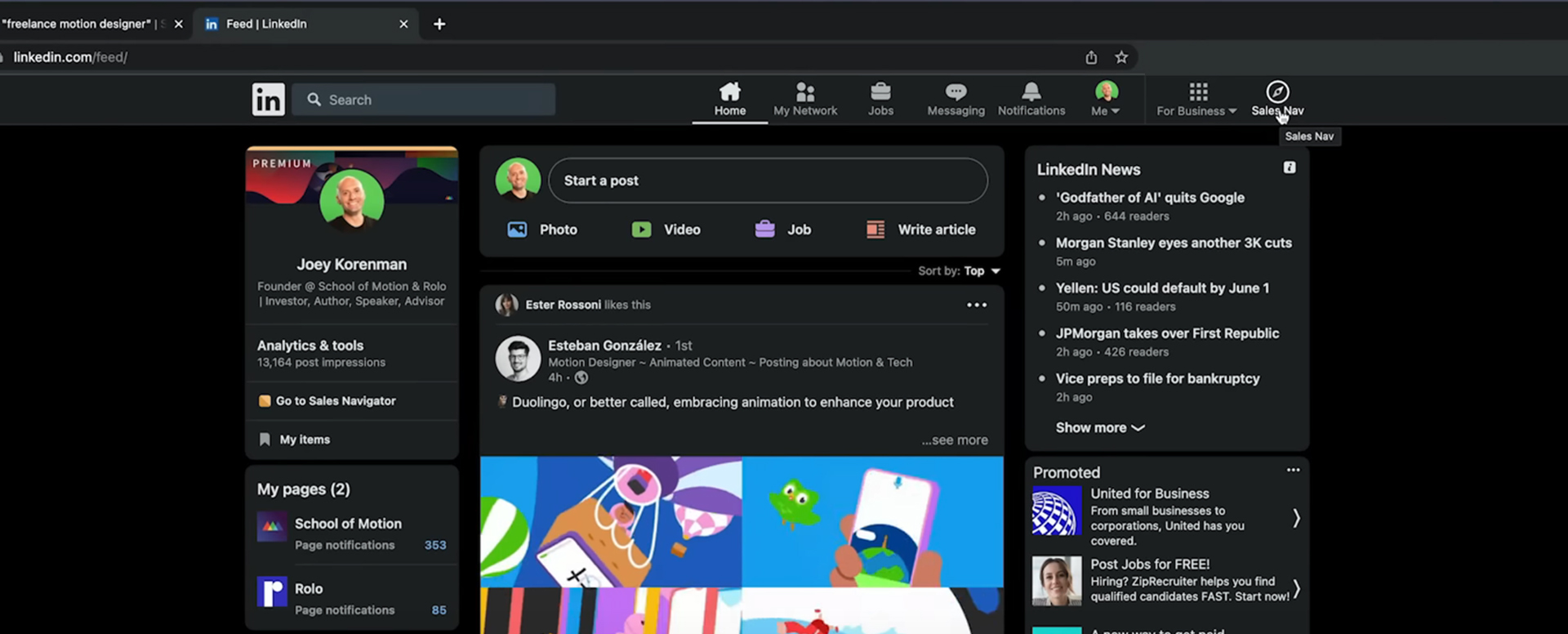
This is linkedin's paid product, and this is what the interface looks like. Sales Navigator is a sales tool. Now you may not like the word sales, but if you're a freelancer and you're looking for clients I got some bad news for you. You're doing sales, and if you're looking for a full-time gig and so you're reaching out to companies to see if they're hiring guess what? You're also doing sales. Sales Navigator is this pretty amazing platform that has all of these tools and really really advanced search features that make it much easier and faster to use than the vanilla LinkedIn search.
So let me show you what I mean here. I'm going to search for motion designer. Now the first thing I want you to notice is that I'm getting 500,000 results. Significantly more than I was getting with the vanilla search in LinkedIn and that's because sales Navigator doesn't limit you to searching one geography at a time. You can search the entire global population of people who use LinkedIn so this is a list of basically every motion designer on LinkedIn. Now what if I go to company headcount? So I'm looking for motion designers who work at companies with 11 to 50 employees now. What's magical about 11 to 50 employees? Well you can play around with this but if a company is really small like less than 10 people, that's a really small startup and they are less likely, in my experience anyway, to be consistently hiring freelancers. Now if they have 50 to 100 or even more employees, they probably are hiring freelancers but those companies tend to be a little more difficult to get into initially. They tend to have more bureaucracy, they have HR departments, and so it just takes a little bit longer to actually get your foot in the door. But companies that are between 11 and 50, that's a sweet spot! They generally have enough revenue and they're also going to be busy enough and have some management where they can hire freelancers, and do so consistently.
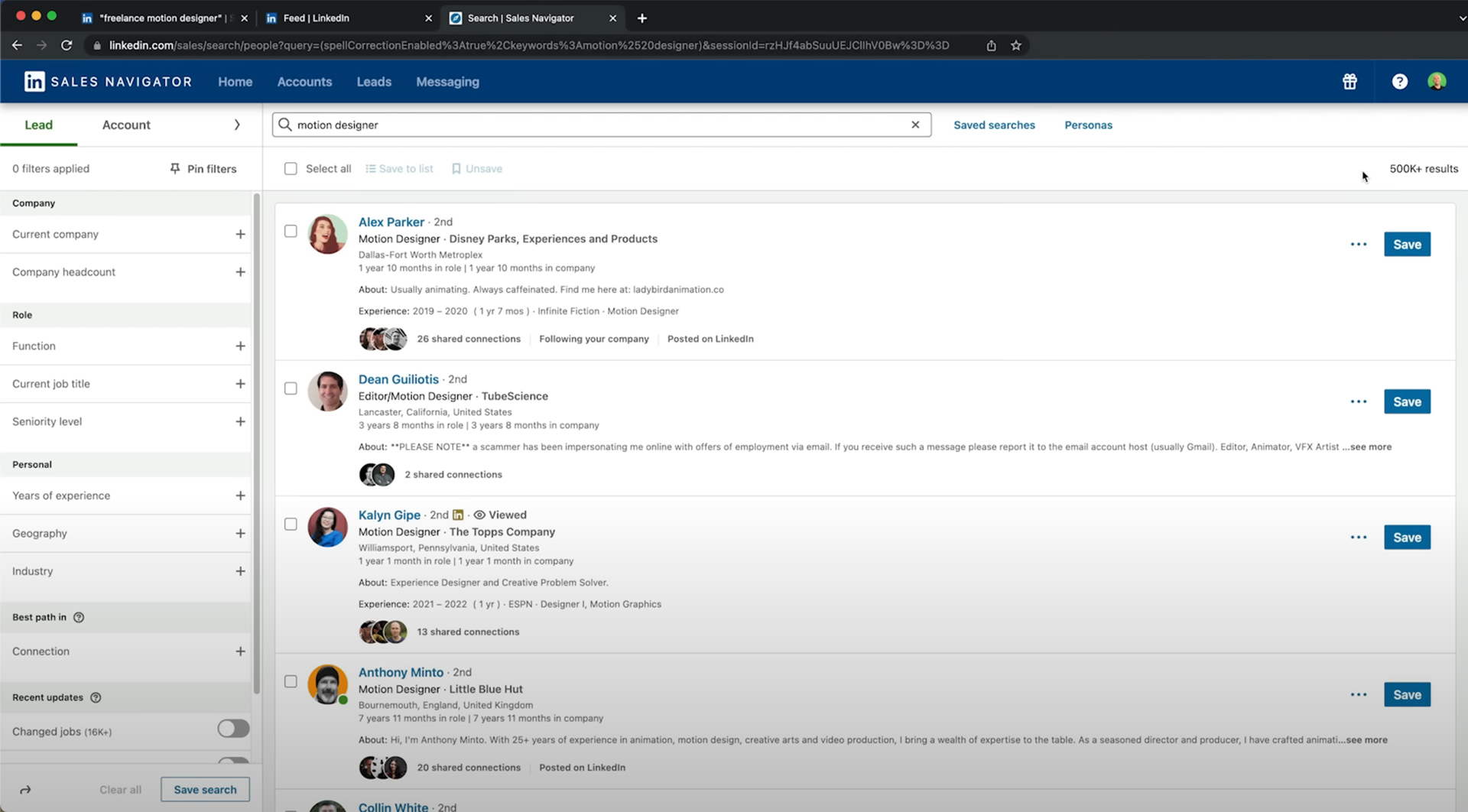
So now we've narrowed down the results to 91,000 results. Let's put on our Sherlock Holmes hat. We now have a list of motion designers who are working at studios or companies that are a good target size for us, but what are some other clues that we could think of that would help us know that those companies are likely to hire freelance motion designers. If that company has only been around for say a year or two, then you can assume that it's maybe a little bit less stable a little bit less mature of a company than one that's been around for longer. So why don't we eliminate companies that haven't been around for at least two years.
There's kind of a proxy for that, which is how long has the person that you're looking at actually been at that company? So why don't we narrow our search for motion designers who are at a company of this size, and who have been there for at least two years. The way you do that is to scroll down to see all filters and then in the role section go to years in current company and say three to five years. We can also add six to ten years, and why not also add more than 10 years great we still have 30,000 results. It probably makes sense to narrow down the geography so why don't we just say United States. If we're a freelancer, we're probably looking for remote. So now we have 7,500 results. Hopefully now you're starting to see how powerful this is. We have 7,500 motion designers working at companies with between 11 and 50 employees, and they've been there for at least two years. So what if we decide that we would really like to get in with more ad agency work because ad agencies tend to book freelancers for longer term projects. They tend to give a little bit more creative control, at least in my experience, to freelance motion designers and it's a little bit easier to get bigger budgets and do project rates with an ad agency versus a motion design studio.
We can come down to personal and select industry and we could look for advertising. We've got advertising services, media production, there's a lot of different types of industries that you could filter for. I'm going to pick advertising services, include those so now we're down to about a thousand results. So we're getting somewhere but let's say that you're just starting out and you know that ad agencies in cities like San Francisco, New York, Chicago, and Boston are the big dogs, at least in the United States. That also means they're going to be a little bit trickier to get into right now, so it might be easier initially to go after agents he's in smaller markets. So why don't we exclude some of the bigger markets so we can go to geography and we can exclude some of those bigger markets. I'm going to just say New York City exclude, and then we'll do San Francisco Bay Area exclude, we could also exclude Chicago and Boston. Down here I see a motion designer who lives in Los Angeles, and so I'm going to exclude that too because that's another major market. We've been pretty surgical with this search, let's take a look and see what the results are.
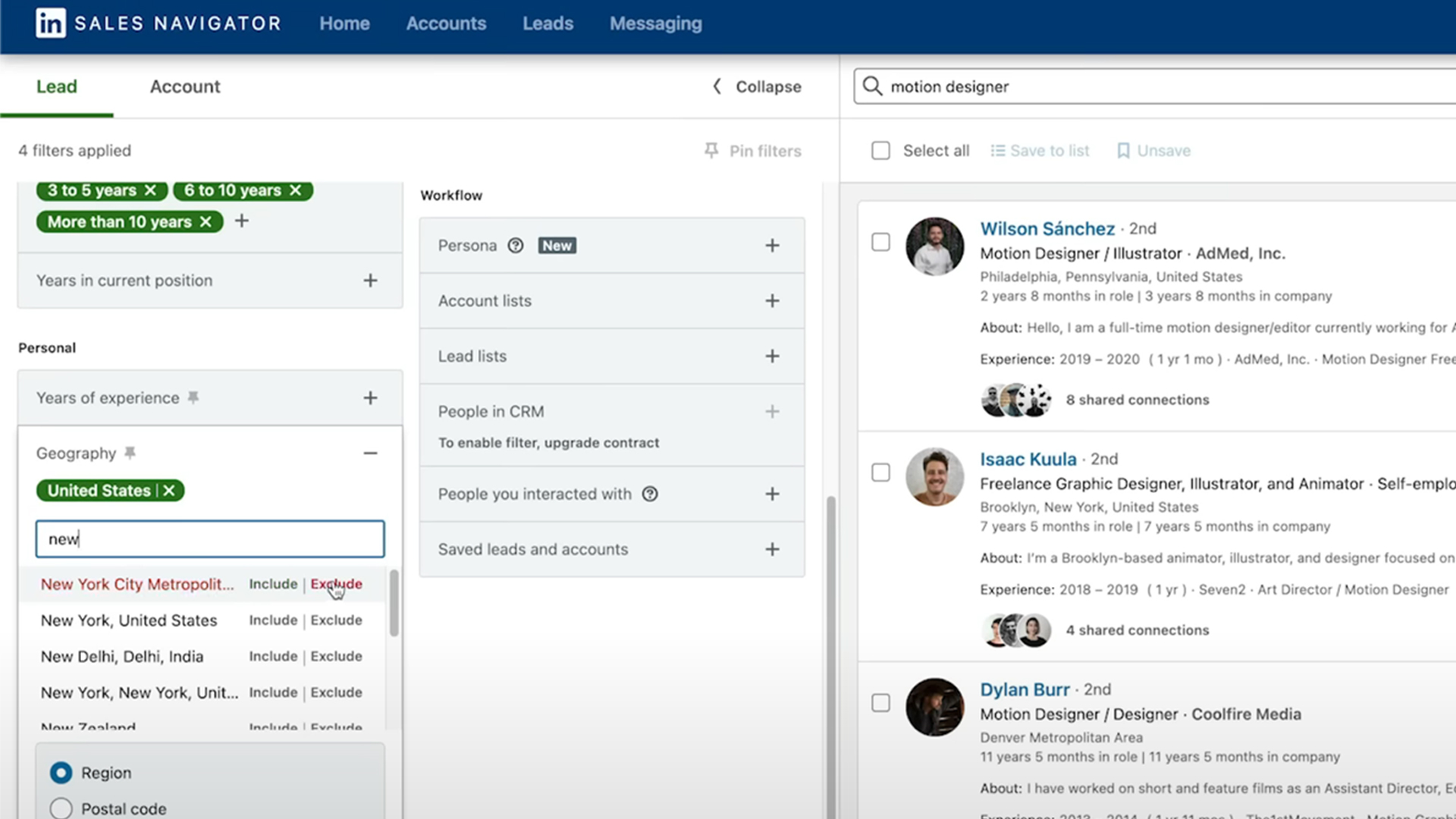
The first result is for AdMed Incorporated, an integrated agency that designs and delivers modern training tools for pharmaceutical biotech blah, blah, blah. Okay so this is an agency that specializes in the medical world. Biotech has big budgets, they have lots of money and so if you can get in with one of these agencies, this is a great bread and butter type of client. I've never heard of this company, but now I would definitely reach out to them. What about Coolfire Media in Denver? Let's hover over this, a content creation studio producing for brands as well as broadcasting digital channels. That sounds right up the alley of any sort of generalist motion designer. You've got DigitalImaging Group in Houston Texas, you've got O'Brien Advertising in Virginia Beach, so now you have a list of potential clients. That is way more specific than what most motion designers are actually going to be able to generate.
Let me show you one more thing you can do. Let's say we're interested in this AdMed Incorporated company, so I'm going to go ahead and click on that. Now this is why it's important that I filter by the number of employees if this was a massive ad agency that had 2,000 employees it would be pretty difficult for me to know exactly which person to reach out to to let them know that I'm a freelancer. It's not impossible and as you get more experience you'll learn how to do that. We talk about it in The Client Code, the class at School of Motion that dives really deep into all these techniques, but it's much easier to start with smaller companies because it's a lot easier to tell who the decision makers are. What's great about Sales Navigator is you can see all of the employees with one click, but it also attempts to tell you who the decision makers are. Here is the CEO of AdMed, Joan, and I could do my homework and go to her profile and try to decide if I think she's the right person to reach out to. In this case, I would assume not because if this is a medically oriented company, I wouldn't assume that their CEO actually comes from the advertising world. Maybe she does, but she more likely is going to have some background in the biotech world and so I think it's actually going to be better to look for someone with a marketing title or a producer, sort of video title.
Let's go back and look at all employees and now we can just kind of go down and read through these job titles and see if we find anyone that feels like the right person to reach out to. Wilson, who's the motion designer on staff. There is a talent acquisition specialist, which that might be the title they use for the person finding artists to work with. There's a senior project manager and a project manager, and in a lot of companies project manager means a similar thing as producer. I'd probably do my research on these two people and decide if maybe I should reach out to them. Ah, there is a multimedia producer, Bernardo. You and I, we're gonna be buddies. Bernardo is almost certainly the right person for me to reach out to and at the very least I would reach out he would tell me who at the company I should actually be talking to.
You saw how quickly I was able to hone in on a really specific type of company, and not only find the company, but find the key decision maker or decision makers there. The next step would be to get some contact info, reach out, start building that relationship and eventually getting booked. I teach that entire process in excruciating detail in The Client Code at School of Motion. This video is just scratching the surface.
In that class I teach you not only how to identify companies like this, but:
- how to identify the stakeholders at them
- how to do your homework
- find out how to build rapport really quickly with people
- how to get contact information
- how to verify that information
- how to write the perfect cold email
- how to follow up
- how to use tools and automation to make your life easier
If you're interested check that out. I hope this gave you a lot to think about, maybe some new tricks to try on LinkedIn, and if you're on the fence about Sales Navigator I would highly recommend paying for one month and just trying it. Even if you just used it every day for a month and built up a giant leads list, it's so worth it. Especially if you're a freelancer but maybe even more so if you're looking for full-time. Most people looking for full-time jobs are not using this tool and you have a huge advantage in identifying companies that maybe aren't as good at getting their name out there in front of motion designers. You could be one of the only designers reaching out directly to a stakeholder saying hey I'm available for work.


The Client Code
The freelancer’s guide to finding, booking, and keeping clients. Drive your freelance motion design career to the next level with a repeatable method of finding, contacting, and landing clients. You’ll learn new ways of identifying prospects and nurturing leads, plus how to develop a freelance philosophy that keeps you thriving through chaos. See this system in action so you can implement it yourself!
This is a self-paced instant access course, so you can get started right away!









